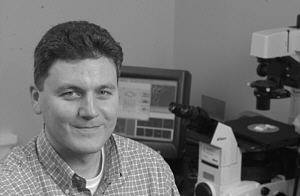|
|
Cellular Pathway Contains a 'Clock' That Steers Gene ActivityBy Phil SneidermanHomewood |

Researchers have discovered a biochemical "clock" that appears to play a crucial role in the way information is sent from the surface of a cell to its nucleus. These messages can cause the cell to thrive or commit suicide, and manipulating them could lead to new treatments for cancer and other diseases, the researchers say.
The findings, based on computer models developed at Johns Hopkins and laboratory experiments conducted at Caltech, are reported in the Nov. 8 issue of the journal Science.
Scientists have known that living cells send messages from their surfaces to their nuclei by setting off a chain of chemical reactions that pass the information along like signals traveling over a telephone wire. Such reaction chains are called signaling pathways. But while studying the NF-kappaB pathway within mouse cells, the university researchers learned that the signal transmission process is even more complicated than they had previously thought.

|
| Andre Levchenko, an assistant professor in the Department of Biomedical Engineering, says the computer models he developed could expedite the development of pharmaceuticals. |
"We found that if the pathway was activated for a short time, a single pulse of activity was delivered to the nucleus, like a single tick of a clock, activating a set of genes," says Andre Levchenko, assistant professor in the Department of Biomedical Engineering at Johns Hopkins. "But longer activation could produce more pulses and induce a larger gene set. We believe that the timing between pulses is critical. If too much or too little time elapsed, the genetic machinery would not respond properly."
Levchenko and his colleagues concluded that the signaling pathway inside a cell was serving as much more than a simple wire. "It was not just carrying the information; it was processing it," says Levchenko, a lead author on the Science paper. "The pathway was operating like a clock with a pendulum, delivering the signal at particular intervals of time in a way that could resonate with the behavior of the genes in the nucleus."
When information moves through a cell pathway to genes in the nucleus, it prompts the genes to send out their own instructions, directing the cell to assemble proteins to carry out various tasks. By developing a better understanding of the way information travels along a pathway, Levchenko says, researchers may be able to create drugs that disrupt or change this line of communication and, in turn, affect overall functioning within the cell. For example, a drug designed to shut down the NF-kappaB pathway might cause a cancer cell to commit suicide through a biological process called apoptosis. "We know that cancer cells use this pathway," he says. "If we can find a smart way to cut this 'wire,' it will be much easier to kill the cancer cells."
The researchers made their discovery by first developing a computer model showing how they believed the pathway operates. Then they verified their results by studying live cells in the lab. Finally, they used the validated model to guide further experiments. Although mouse cells called fibroblasts were used, Levchenko says the findings should also hold true for human fibroblasts and other cell types.
Because the computer model has been validated, it could be used to speed up the development of pharmaceuticals that might affect the cell pathway, says Levchenko, who is a part of a computational biology research team based at the Whitaker Biomedical Engineering Institute at Johns Hopkins. He says drug developers could use the computer model to test quickly how various compounds may affect the cell behavior before launching more time-consuming lab tests with live cells. "This has given us a very good tool to predict things that may happen when the pathway properties are altered, reducing the need to engage in exhaustive animal tests," Levchenko says.
The other lead author of the Science paper was Alexander Hoffman, who engaged in the research as a postdoctoral scholar at Caltech and now is an assistant professor of biology at the University of California, San Diego. The co-authors were Martin L. Scott, who conducted research at MIT and who now is employed by Biogen; and David Baltimore, president of Caltech.
| GO TO NOVEMBER 18, 2002 TABLE OF CONTENTS. |
| GO TO THE GAZETTE HOME PAGE. |